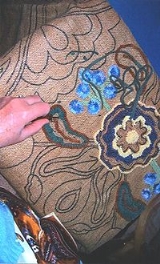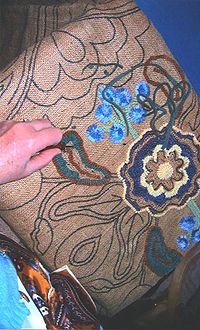
Burlap
Encyclopedia

Hessian or burlap in the US, is a woven fabric
Textile
A textile or cloth is a flexible woven material consisting of a network of natural or artificial fibres often referred to as thread or yarn. Yarn is produced by spinning raw fibres of wool, flax, cotton, or other material to produce long strands...
usually made from skin of the jute
Jute
Jute is a long, soft, shiny vegetable fibre that can be spun into coarse, strong threads. It is produced from plants in the genus Corchorus, which has been classified in the family Tiliaceae, or more recently in Malvaceae....
plant or sisal
Sisal
Sisal is an agave that yields a stiff fibre traditionally used in making twine, rope and also dartboards. The term may refer either to the plant or the fibre, depending on context...
fibres, or may be combined with other vegetable fibre
Fiber crop
Fiber crops are field crops grown for their fibers, which are traditionally used to make paper, cloth, or rope. The fibers may be chemically modified, like in viscose or cellophane...
s to make rope
Rope
A rope is a length of fibres, twisted or braided together to improve strength for pulling and connecting. It has tensile strength but is too flexible to provide compressive strength...
, nets
Net (textile)
Net or netting is any textile in which the warp and weft yarns are looped or knotted at their intersections, resulting in a fabric with large open spaces between the yarns....
, and similar products. Gunny
Gunny sack
A gunny sack is an inexpensive bag made of burlap, also known as a 'gunny shoe'. Gunny sacks are traditionally used for transporting grains, potatoes, and other agricultural products. Today they are also sometimes used as sandbags for erosion control. They are usually made from jute or other...
cloth is similar.
Hessian, a dense woven fabric, has been historically produced as a coarse fabric, but more recently it is being used in a refined state known simply as jute
Jute
Jute is a long, soft, shiny vegetable fibre that can be spun into coarse, strong threads. It is produced from plants in the genus Corchorus, which has been classified in the family Tiliaceae, or more recently in Malvaceae....
as an ecofriendly material for bags, rugs, and other products.
The name "burlap" appears to be of unknown origin. The name "hessian" is attributed to the use of the fabric, initially, as part of the uniform of soldiers from the German state of Hessen who were called "Hessians."
History
Hessian was first exported from India in the early 19th century. It was traditionally used as backing for linoleum, rugs and carpet.Shipping and construction
Hessian is often used to make sacks and bags to ship goods like coffee beanCoffee bean
A coffee bean is a seed of a coffee plant. It is the pit inside the red or purple fruit often referred to as a cherry. Even though they are seeds, they are referred to as 'beans' because of their resemblance to true beans. The fruits - coffee cherries or coffee berries - most commonly contain two...
s; these can be described as gunny sack
Gunny sack
A gunny sack is an inexpensive bag made of burlap, also known as a 'gunny shoe'. Gunny sacks are traditionally used for transporting grains, potatoes, and other agricultural products. Today they are also sometimes used as sandbags for erosion control. They are usually made from jute or other...
s. It is breathable and thus resists condensation and associated spoilage of the contents. It is also durable enough to withstand rough handling in transit; these properties have also led to its use for temporary protection as wet covering to prevent rapid moisture loss in setting of cement
Cement
In the most general sense of the word, a cement is a binder, a substance that sets and hardens independently, and can bind other materials together. The word "cement" traces to the Romans, who used the term opus caementicium to describe masonry resembling modern concrete that was made from crushed...
and concrete
Concrete
Concrete is a composite construction material, composed of cement and other cementitious materials such as fly ash and slag cement, aggregate , water and chemical admixtures.The word concrete comes from the Latin word...
by the construction industry. Hessian is also commonly used for making sandbags, empty hessian sacks that, when filled with sand, are used for flood mitigation when building temporary embankments against floodwaters or field fortification
Fortification
Fortifications are military constructions and buildings designed for defence in warfare and military bases. Humans have constructed defensive works for many thousands of years, in a variety of increasingly complex designs...
s.
Landscaping and Agriculture
Hessian is used to wrap the exposed roots of trees and shrubs when transplantingTransplanting
For botanical organ transplant, see GraftingIn agriculture and gardening, transplanting or replanting is the technique of moving a plant from one location to another. Most often this takes the form of starting a plant from seed in optimal conditions, such as in a greenhouse or protected nursery...
, and also for erosion control on steep slopes.
Apparel
Due to its coarse texture, it is not commonly used in modern apparel. However, this roughness gave it a use in a religious context for mortification of the fleshMortification of the flesh
Mortification of the flesh literally means "putting the flesh to death". The term is primarily used in religious and spiritual contexts. The institutional and traditional terminology of this practice in Catholicism is corporal mortification....
, where individuals may wear an abrasive shirt called a cilice
Cilice
A cilice was originally a garment or undergarment made of coarse cloth or animal hair used in some religious traditions to induce some degree of discomfort or pain as a sign of repentance and atonement...
or "hairshirt" and in the wearing of "sackcloth" on Ash Wednesday
Ash Wednesday
Ash Wednesday, in the calendar of Western Christianity, is the first day of Lent and occurs 46 days before Easter. It is a moveable fast, falling on a different date each year because it is dependent on the date of Easter...
.
Owing to its durability, open weave, naturally non-shiny refraction, and fuzzy texture, Ghillie suit
Ghillie suit
A ghillie suit, wookie suit, yowie suit, or camo tent is a type of camouflage clothing designed to resemble heavy foliage. Typically, it is a net or cloth garment covered in loose strips of cloth or twine, sometimes made to look like leaves and twigs, and optionally augmented with scraps of foliage...
s for 3D camouflage are often made of hessian. It was also a popular material for camouflage
Camouflage
Camouflage is a method of concealment that allows an otherwise visible animal, military vehicle, or other object to remain unnoticed, by blending with its environment. Examples include a leopard's spotted coat, the battledress of a modern soldier and a leaf-mimic butterfly...
scrim on combat helmets of World War II
World War II
World War II, or the Second World War , was a global conflict lasting from 1939 to 1945, involving most of the world's nations—including all of the great powers—eventually forming two opposing military alliances: the Allies and the Axis...
. Until the advent of the plastic "leafy" multi-color net system following the Vietnam War
Vietnam War
The Vietnam War was a Cold War-era military conflict that occurred in Vietnam, Laos, and Cambodia from 1 November 1955 to the fall of Saigon on 30 April 1975. This war followed the First Indochina War and was fought between North Vietnam, supported by its communist allies, and the government of...
, burlap scrim was also woven onto shrimp and fish netting to create large-scale military camouflage netting.

